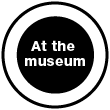


 |
||
 |
||
|
The museum display is an interactive, three-dimensional model of a familiar illusion: A line with arrows pointing outward on either side is perceived as shorter than a line of exactly the same length with arrows pointing inward. This famous illusion was discovered in 1889, but there's still no generally accepted explanation for it. The most familiar explanation is that the brain perceives the line with the inward-pointing arrows as sunken, and the line with the outward-pointing arrows as protruding. When a distance-correction mechanism in our brain is activated, the line with the inward-pointing arrows appears to be longer. Since this explanation does not work for other examples of the illusion, researchers are still trying to come up with a better one.
Scientists refer to this as the Müller-Lyer illusion, named for the German psychiatrist who discovered it. The explanation is simple: the direction of the arrows causes the brain to assume, mistakenly, that one line (the right one in the drawing) is further away than the other (the left one here). When our brain's distance repair mechanism is working (see the Size Doesn't Matter illusion), we perceive the right-hand line as longer. Source: the Amazing Art website. The illusion is a familiar one, but did you know that it also works as a tactile (touch) illusion? To demonstrate it, people are blindfolded and given bars with arrows and tails to touch. (And the same results occur with people who are blind from birth.) According to some researchers, the fact that the illusion works tactically as well is strong proof that the perspective explanation (see the picture above) given in many textbooks is simply wrong. Below are several examples of illusions. The perspective explanation will not work for figures B and D.
Links: Related exhibit:
|
||

 A 120-Year-Old Illusion
A 120-Year-Old Illusion
